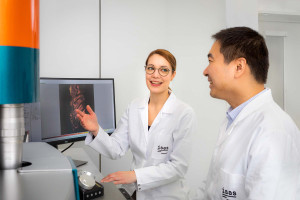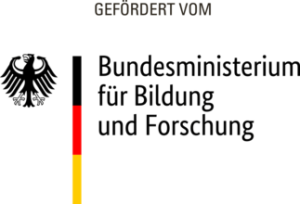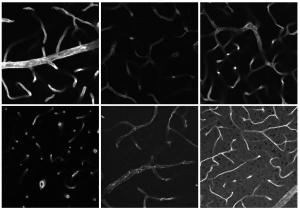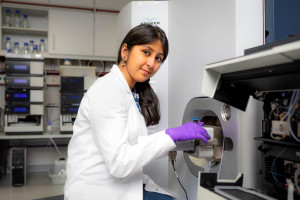Dortmund, 24th May 2022
Microscopy is just one of many fields of application in medical imaging that can hardly be imagined without artificial intelligence (AI) in the processing of enormous amounts of data. Because humans cognitively reach their limits despite existing programmes for image evaluation, the AI experts at ISAS are developing eyes and brains for computers. Prof. Dr. Anika Grüneboom, head of Bioimaging, and Dr. Jianxu Chen, head of the AMBIOM junior research group, each report in their statements why the interdisciplinary cooperation of their research groups is vital to their work and what the advantages are.

Prof. Dr. Anika Grüneboom (left) and Dr. Jianxu Chen talk about images of blood vessels in the murine mandible (lower jaw of the mouse), which were previously taken using the light sheet fluorescence microscope.
© ISAS
Prof. Dr. Anika Grüneboom, head of Bioimaging
"The cells in our blood vessels talk to each other. How they interact with each other, how far apart they are – all this provides us with important insights into inflammatory diseases. The cells of our immune system communicate with each other as well as with the endothelial cells that line the innermost layer of the blood vessels. This communication controls where immune cells attach to blood vessels, migrate through them, and then enter surrounding tissues to fight inflammation. In autoimmune diseases such as rheumatoid arthritis, however, the infiltration of immune cells into tissue does not lead to healing of the inflammation, but rather worsens it and ultimately causes the disease to become chronic. Therefore, we would like to identify criteria that will allow us, in the future, to detect these processes in the blood or tissue of each individual person before the actual onset of disease – that is, long before these inflammations become chronic.
For example, in my research group we examine the inner layer of blood vessels under the light sheet fluorescence microscope. We are studying which cells are involved in inflammatory processes, what the cell walls look like, how far apart the cells are from each other and how the cells communicate with each other. The light sheet fluorescence microscope expands the laser beam like a sheet of paper, and this thin disk of light that is created illuminates each individual plane of our samples and takes a picture of each plane. We later assemble the individual images into a 3D model on the computer. On average, we can produce well over 500 images from a single sample under the microscope, and we usually work with more than 20 samples per test series. The many images that the microscope creates pose a great challenge for us. Although there are computer programs available today, we researchers still spend a lot of time evaluating all the information from these images. Artificial intelligence can help us with this task much better than an individual computer program."
What does AI mean for the analysis of microscopic images?
Dr. Jianxu Chen, head of AMBIOM
"Communication is key – not only between the cells in our body, but also between our research groups. With Artificial intelligence (AI), we can merge high amounts of data. There a mainly three important things that machines can do that humans simply cannot. That is why there is a high potential for a deeper synergy between microscopic image analyses and AI.
First of all, AI lets us analyse way more images and thus gives us a higher throughput than an ordinary computer programmes. We can have intelligent machines analyses large amount of pictures with a precise outcome. Second, a big advantage is that AI can see things that are not visible for the human eye. AI is able to interpret every information in the images. For example: The human eye can look at the images and concentrate on the thickness of the blood vessels. AI can look at the same images, but evaluate more: not only the blood vessels’ thickness, but also how rough their surface is, what is happening next to their walls, and even more. Third, our human brain is limited, whereas intelligent machines do not have that limitation. They are able to extract information and build knowledge that the human brain can hardly process. That is why my research group programs algorithms that serve as the eyes and brains for computers.
When we design our algorithms, we make sure that we are accurate and at the same time sustainable in terms of using power resources. What is also crucial is that we believe science should be transparent. Therefore, our analyses are fully reproducible, because my team’s work is based on open source. It is important to us at ISAS that scientist all around the world have access to the AI methods that we develop here in Dortmund."
The MSCoreSys associated junior research group AMBiOM – Analysis of Microscopic BiOMedical Images is funded by the Federal Ministry of Education and Research (Bundesministerium für Bildung und Forschung, BMBF) under the funding reference 161L0272.









